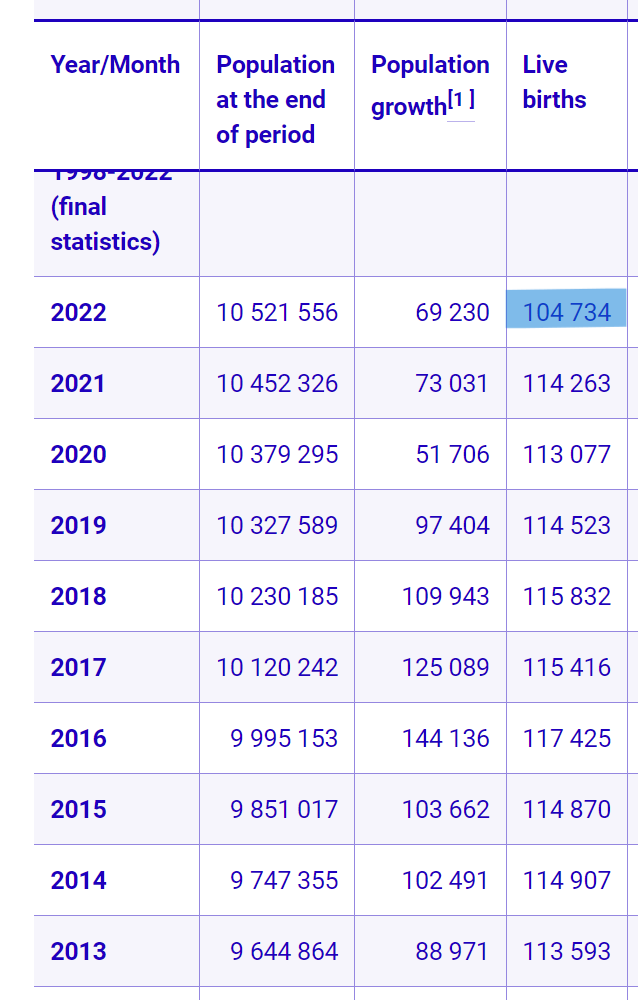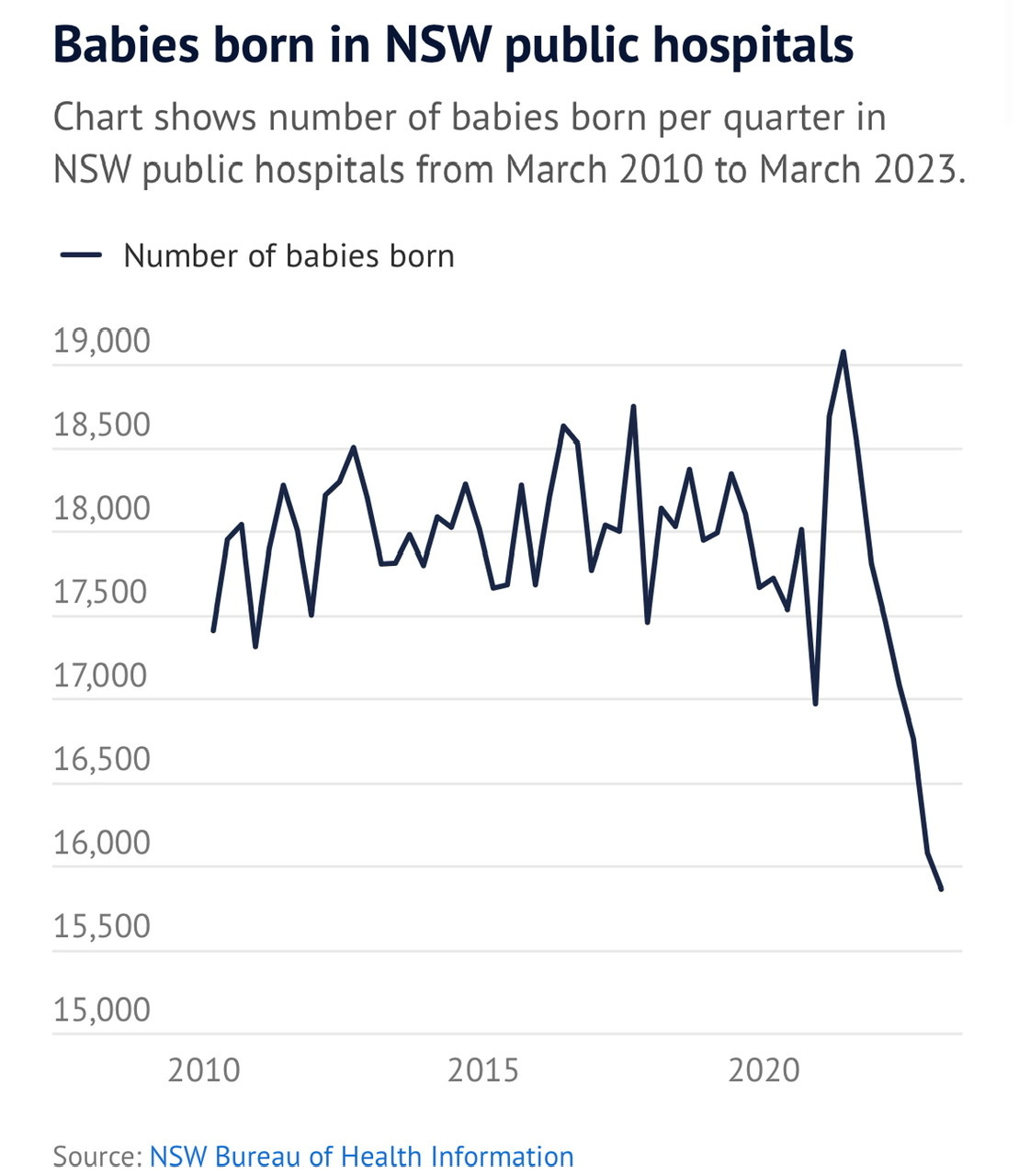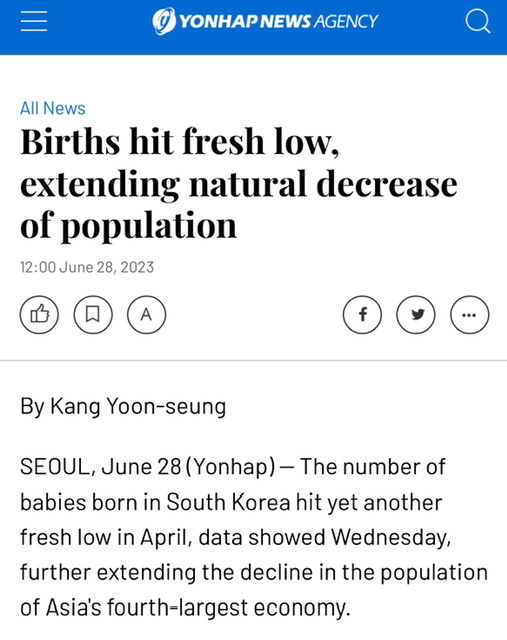VERY URGENT: The fertility crisis in mRNA countries is deepening
Guest Post by Alex Berenson
Why will no one investigate the plunge in births since 2021?
The global baby bust is worsening – and the problem is deepest in countries that relied most heavily on mRNA Covid shots.
Most notably, several nations that had stable birth levels before the mRNAs were introduced in 2021 have seen sharp drops since. Sweden had about 115,000 births annually from 2012 to 2021. Last year, births plunged to 105,000. In 2023, they are tracking below 100,000. Germany has a similar trend.
Meanwhile, Eastern European nations like Bulgaria – which had much lower mRNA jab rates – have seen in some cases increases in births in the last year.
The trend is not universal, and how the jabs might damage fertility remains unclear. They cause serious menstrual changes in many women, but large studies show their use in pregnancy does not cause miscarriages. If they are doing harm, it probably comes earlier, by reducing the odds of conception or implantation of new embryos. Several studies show sperm declines in men who’ve received them.
Yet governments, scientists, and the media have shied from examining possible mRNA links to infertility. Instead they mock or ignore anyone who mentions it.
The mRNA countries suffering the biggest fertility crisis are not in Europe.
East Asian nations with near-universal mRNA jab uptake among adults already had shriveling birth rates. But since early 2022, they have seen births fall to levels previously considered unthinkable.
The crisis is most profound in South Korea, a country of 51 million that had barely 600 births a day in April. The South Korean birthrate is now barely one-third the level needed to keep the country’s population stable. Taiwan and Japan are barely in better shape. Japan had almost twice as many deaths as births last year.
The trend comes with caveats.
Spain and Italy – which previously had birth rates lower than northern European countries – have seen smaller declines since early 2022. Births also fell last year in China, which did not use mRNA vaccines, although Chinese statistics are unreliable and China’s lockdown lasted far longer than other countries, making international comparisons difficult.
—
(Annual births in Sweden. One of these years is not like the others. And 2023 has been worse.)

(SOURCE)
—
(As above, so below… NSW stands for New South Wales, the largest state in Australia. Nothing to see here, folks, nothing to see here:)

(SOURCE)
—
The post-jab decline is particularly striking because births rose in many countries in 2021, following a brief drop in winter 2021. But in early 2022 – roughly nine months after the rollout of the mRNAs to adults of childbearing age – they began to drop again. They have not recovered.
A recent paper called “Pandemic Roller-Coaster” explained the trend:
The initial pandemic shock was associated with a fall in births in most countries, with the sharpest drop in January 2021… most countries reported a stable or slightly increasing number of births in the subsequent months, especially in autumn 2021.
Yet another, quite unexpected, downturn in births started in January 2022, linked with the conceptions in spring 2021 when the pandemic measures were mostly eased out and vaccination was gaining momentum. [emphasis added]
The paper’s data series ended in September 2022, but the trends have only become more pronounced since then.
—
Yet media outlets have hardly written about the plunging births. When they do, they go out of their way to look for non-mRNA explanations. When it reported the birth plunge in New South Wales, an Australian newspaper offered this howler:
Dr Liz Allen, a demographer at the Australian National University, said the decline in births was due to both short-term factors – such as couples bringing forward their pregnancy plans during COVID – and longer-term factors such as concerns about housing and climate change.
Because no one ever thought about climate change before 2021!
In a separate anything-but-the-vaccines “fact-check” a few days ago, a professor of demography at the Australian National University claimed “there is great variability in births over short time periods,” a statement she must know is untrue. Births do rise and fall over time, but major changes typically take several years, if not decades.
In fact, before 2021, fertility in Europe had been largely stable overall for two decades, as Eurostat – the European Commission’s statistics unit – reported in March 2023. After falling in the late 20th century, the rate of births per woman of childbearing age actually rose slightly between 2000 and 2021, probably because of a high birth rate from Muslim migrants to Europe.
—
(It wasn’t supposed to be a documentary. Also, whatever happened to Clive Owen?)

—
You might think that the recent birth collapse would have policymakers and scientists looking hard at mRNA – a novel biotechnology whose effects on fertility had hardly been studied.
You would be wrong.
Only a handful of tiny studies, nearly all outside the United States and Europe, have examined the impact of the mRNAs on sperm. Their results have been far from reassuring. A year ago, Israeli researchers reported that the Pfizer jab:
After examining semen from 37 donors, the scientists found that “motile” sperm – sperm that swim in a mostly straight line and theoretically can implant an egg – fell 22 percent about three months after a BNT162b2 shot. The three-month cutoff is crucial because a full cycle of sperm production lasts about two months. Testing less than two months after vaccination may not capture the effects of the jabs.
At least three other small studies have hinted at similar problems – though the scientists who conducted them have generally downplayed their findings.
In March 2023, Japanese researchers reported that an index of sperm motility had dropped sharply in 10 donors 12 weeks after their second dose; the donors had been prospectively recruited. Raw numbers of motile sperm also dropped sharply, by more than 30 percent from pre-vaccination to after the second dose.
Meanwhile, South African researchers found a roughly 20 percent decrease in mean motile sperm count after vaccination in 46 men who were having their semen tested at a fertility clinic. (Twenty-nine men had received the Pfizer jab, while all but one of the rest received Johnson & Johnson’s shot.)
Similarly, researchers at two fertility clinics in Iraq reported “a slight reduction in both total motility and progressive motility after the Pfizer-BioNTech mRNA COVID-19 vaccine” in 60 men under age 50.
—
(South Korea: go long cemeteries and short nurseries)

(SOURCE)
—
What about larger, longer-term studies that might offer a definitive answer to whether the mRNA jabs have impaired sperm counts or quality?
They don’t exist. One small Israeli study on 58 men published in September 2022 found no difference in counts after six to 14 months. If other long-term studies have been published or are being conducted, I have not found them. The National Institutes of Health is spending over $1 billion to research the nonexistent problem of long Covid – and nothing on an issue that, no exaggeration, affects the future of humanity.
Studies of whether the jabs may affect the ability of women to conceive naturally are even harder to find. Several researchers have reported the jabs do not seem to lower the rate of successful pregnancies of embryos implanted after in vitro fertilization.
But IVF inherently is very different than natural pregnancy. No one disputes the jabs can affect menstrual cycles for months. Might they cause permanent changes in the uterine lining, making implantation more difficult? Again, little research has been conducted. One large study published in January 2022 offered a reassuring finding, showing no difference in self-reported fertility in a sample of 2,126 American and Canadian women attempting to conceive in 2021.
—
The lack of research would not matter if births weren’t plunging.
But they are.
What will have to happen for us to start trying to find out why?
This article has been archived for your research. The original version from The Burning Platform can be found here.


